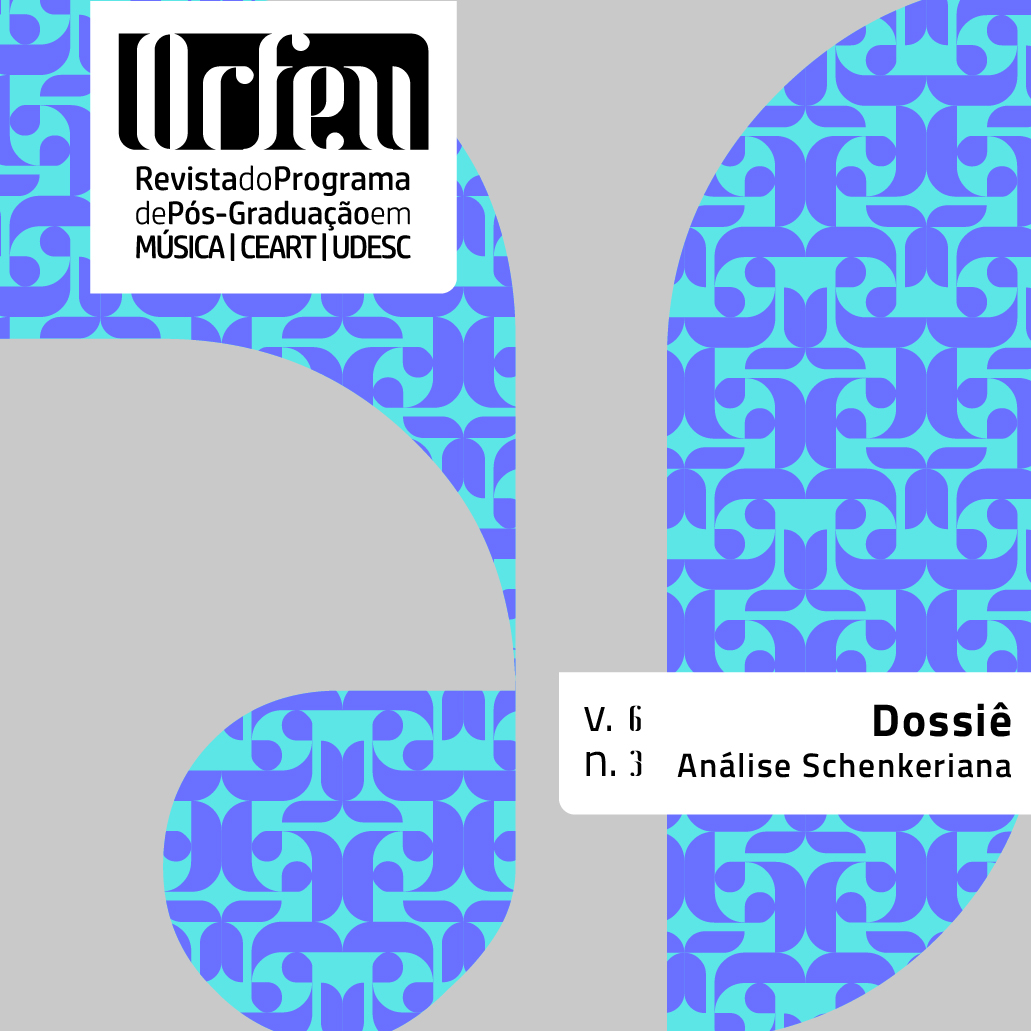The Art of Modulating, Preludizing, and Fantasizing: Schenker’s Thoughts about Keys and Key Change Reconsidered
DOI:
https://doi.org/10.5965/2525530406032021032Palabras clave:
Fantasies, Heinrich Schenker, Ludwig van Beethoven, Preludes, ModulationResumen
Although Heinrich Schenker certainly changed his mind about many topics, he never waivered in his belief that 1) current ways to explain modulation were fundamentally flawed; and 2) that modulation is best learned by improvising preludes and fantasies. To explain these points, Part I reconsiders Schenker’s critique of Max Reger’s Beiträge zur Modulationslehre (1903) and Salomon Jadassohn’s Die Kunst zu Modulieren und zu Präludieren (1890) and describes three types of modulation endorsed by Schenker in his Harmonielehre (1906): 1) [diatonic] reinterpretation; 2) chromaticism; and 3) enharmonicism. Part II then shows how Schenker not only dispensed with the traditional concepts of relative, close, and distant keys, but he eventually proposed that modulations arise at the foreground for contrapuntal, even motivic reasons. Finally, Part III uses Schenker’s claims about modulating and preludizing to analyze Beethoven’s “Two Preludes” in C major, Op. 39, both of which modulate “through all twelve major keys.”
Descargas
Citas
BACH, C.P.E. Versuch über die wahre Art das Clavier zu spielen. Berlin: Winter, 1759, 1762. Tr. by W. MITCHELL as Essay on the True Art of Playing Keyboard Instruments. London: Eulenburg, 1974.
BLUMRÖDER, C. 1972. Modulatio / Modulation. In Handwörterbuch der musikalischen Terminologie, ed. by H. EGGEBRECHT, v.4, p.1-20, 1983.
BROWN, M, HEADLAM, D., DEMPSTER, D. The ♯IV(♭V) Hypothesis: Testing the Limits of Schenker’s Theory of Tonality. Music Theory Spectrum, v.19, n.2, p.155–183, 1997.
CAEYERS, J. Beethoven: A Life, tr. by B. ANNABLE. Berkeley, CA: University of California Press, 2020.
COOK, N. The Schenker Project. Oxford: Oxford University Press, 2007.
CZERNY, C. “Recollections from My Life” [1842], tr. E. SANDERS, The Musical Quarterly, v. 42, n.3, p.302-317, 1956.
GJERDINGEN, R. Music in the Galant Style. New York: Oxford University Press, 2007.
GREEN, J. F. New Hess Catalog. West Newberry, VT: Vance Brook Publishing, 2003.
HINTERBERGER, H. Enthaltend die Bibliothek des Herrn Dr. Heinrich Schenker. Wien Katalog XII. Vienna: Antiquariat Hinterberger, 1935.
JADASSOHN, S. Die Kunst zu Modulieren und zu Präludieren. Leipzig: Breitkopf und Härtel, 1890.
JADASSOHN, S. Lehrbuch der Harmonie. Leipzig: Breitkopf & Härtel, 1883.
JONAS, O. Das Wesen des musikalischen Kunstwerks: Einführung in die Lehre Heinrich Schenkers. Vienna: Saturn-Verlag, 1934. Ed. and tr. by J. ROTHGEB as Introduction to the Theory of Heinrich Schenker. New York: Longman, 1982.
LAUFER, E. On the Fantasy. Intégral v.2, p.99-133, 1988.
LOUIS, R.; THUILLE, L. Harmonielehre. Stuttgart: Carl Grüninger Verlag, 1907.
MITCHELL, W. J. Modulation in C.P.E. Bach’s Versuch. In Studies in Eighteenth-Century Music, ed. H.C. ROBBINS LANDON and R.E. CHAPMAN. London: George Allen, p.333-342, 1970.
QUANTZ, J.J., Versuch einer Anweisung die Flöte traversiere zu spielen. Berlin: Voss, 1752. Tr. by E. R. REILLY as On Playing the Flute. New York: Schirmer, 1985.
RASCH, R. The Musical Circle: From Alfonso to Beethoven. The Dutch Journal of Music Theory v.2, n.2, p.110-133, 1997.
RINK, J. Schenker and Improvisation. Journal of Music Theory v.37, n.1, p.1-54, 1993.
REGER, M. Beiträge zur Modulationslehre. Leipzig: C. Kahnt, 1903.
SALZER, F. Haydn’s Fantasia from the String Quartet, Opus 76, No. 6. The Music Forum 4, p.161-194, 1976.
SCHACHTER, C. Analysis by Key: Another Look at Modulation. Music Analysis 6/3 (1987), pp.289–318.
SCHENKER, H. Harmonielehre. Stuttgart and Berlin: Cotta, 1906. Tr. by E. MANN-BORGESE and ed. by O. JONAS as Harmony. Chicago: Chicago University Press, 1954.
SCHOENBERG, A. Structural Functions of Harmony. Rev. ed. Leonard Stein. New York: W. W. Norton, 1969.
SCHOENBERG, A. Kontrapunkt I. Stuttgart and Berlin: Cotta, 1910. Ed. John Rothgeb and tr. J. ROTHGEB and J. THYM as Counterpoint. Ann Arbor, MI: Musicalia, 2001.
SCHOENBERG, A. Die Kunst der Improvisation. In Das Meisterwerk in der Musik v.I. Munich: Drei Masken Verlag, p.11–40, 1925. Tr. by R. KRAMER as The art of improvisation. In The Masterwork in Music v.1, ed. by W. DRABKIN. Cambridge: Cambridge University Press, 2–19, 1994.
SCHOENBERG, A. Ein Gegenbeispiel: Max Reger, Op. 81, Variationen und Fuge über ein Thema von Joh. Seb. Bach für Klavier. In Das Meisterwerk in der Musik v.II. Munich: Drei Masken Verlag, p.173-192, 1926. Tr. by J. ROTHGEB as A counter-example: Max Reger’s Variations and Fugue on a Theme by Bach, Op. 81, for piano. In The Masterwork in Music v.1, ed. by W. DRABKIN. Cambridge: Cambridge University Press, p.106-117, 1994.
SCHOENBERG, A. Der freie Satz. Neue musikalische Theorien und Phantasien 3. Vienna: Universal, 1935. Tr. by E. OSTER as Free Composition. New York: Longman, 1979.
SOLOMON, M. Beethoven’s Productivity at Bonn. Music and Letters, v.53, n.2, p.165-172, 1972.
SWAFFORD, J. Beethoven: Anguish and Triumph. New York: Houghton Mifflin, 2014.
WASON, R. W.; BROWN, M. Heinrich Schenker’s Conception of Harmony. Rochester, NY: University of Rochester Press, 2020.
Descargas
Publicado
Cómo citar
Número
Sección
Licencia
Derechos de autor 2021 John Koslovsky, Matthew Brown

Esta obra está bajo una licencia internacional Creative Commons Atribución 4.0.






